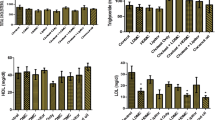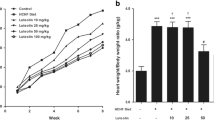Abstract
The present study aimed to investigate the effect of two levels of carob powder 10 and 20 % on lipid profile. Forty male Sprague–Dawley rats were divided into two groups. The first group was fed on a basal diet and acts as a control group. The second group was fed on a hyperlipidemic diet (a basal diet plus 10 % animal fat and 1 % cholesterol). After 6 weeks, the second group was divided into three even subgroups: subgroup 1 was fed on a hyperlipidemic diet, subgroup 2 was fed on a hyperlipidemic diet plus 10 % carob powder, and subgroup 3 was fed on a hyperlipidemic diet plus 20 % carob powder. At the end of the experimental period, serum samples were collected to measure total cholesterol (TC), triglyceride (TG), high-density lipoproteins (HDL), low-density lipoproteins (LDL), and very-low-density lipoproteins (VLDL). Heart and kidney samples were taken for histopathological examination. The obtained results revealed that feeding rats with 10 and 20 % carob powder improved lipid profile parameters and histopathological characteristics in the heart and kidney of experimental rats.


Similar content being viewed by others
References
AHA (2005) Heart disease and stroke statistics, Ed. Dallas, TX: American Heart Association
Ali MME, Abd El-Megeid AA, Abdo Mostafa RA (2012) Effect of some levels from ginseng, barley and carob on lipid profile and kidney functions of rats fed on high fructose diets. J Am Sci 8(10):152–162
Allian CC, Poon LS, Chan CSG, Richmond W (1974) Enzymatic colourimetric method of the determination of plasma total cholesterol. Clin Chem 20:470
Anon (1977) First report of the American Institute of Nutrition. J Nutrition 107:1340–1348
Anon (1980) Second report of the American Institute of Nutrition. J Nutrition 110:1726
Avallone R, Plessi M, Baraldi M, Monzani A (1997) Determination of chemical composition of carob (Ceratonia siliqua): protein, fat, carbohydrates and tannins. J Food Compost Anal 10:166–172
Bancroft TD, Stevens A, Turner DR (1996) Theory and practice of histological technique, 4th edn. Churchill Livingston, New York
Brennan CS (2005) Dietary fiber, glycaemic response and diabetes. Mol Nutr Food Res 49:560–570
Burget L, Caton S, Bai Y, Spangler L, Gruendel S, Koebnick C, Bidlingmaier M (2007) Longterm effects of carob pulp preparations in insoluble fiber on metabolism, body weight and leptin levels in rats. Exp Clin Endocrinol Diabetes 115–124
Deng R (2009) Food and food supplements with hypocholesterolemic effects. Recent patents on food. Nutr Agric 1:15–24
El-Manfaloty MM (2005) Effect of some Egyptian vegetables on the cholesterol in blood serum of white rats. MSc Home Economic, Nutrition and Food Science
Fernandez ML, Webb D (2008) The LDL to HDL cholesterol ratio as a valuable tool to evaluate coronary heart disease risk. J Am Coll Nutr 27(1):1–5
Fossati SF, Prancipel R (1982) Triglycerides determination after enzymatic hydrolysis. Clin Chem 28:2077
Friedewald WT, Levy RI, Fredrickson DS (1972) Determination of high density lipoprotein cholesterol by selective precipitation. Clin Chem 18:499–502
Ilwy YME (2003) The effect of some kinds of seafood (fish) on blood lipid profile in rats. Dissertation, Faculty of Specific Education, Ain Shams University, Egypt
Klaus S, Pultz S, Thone-Reineke C, Wolfram S (2005) Epigallocatechin gallate attenuates diet-induced obesity in mice by decreasing energy absorption and increasing fat oxidation. Int J Obes 29:615–623
Kumazawa S, Taniguchi M, Suzuki Y, Shimura M, Kwon MS, Nakayama T (2002) Antioxidant activity of polyphenols in carob pods. J Agric Food Chem 50(2):373–377
Makris DP, Kefalos P (2004) Carob pods (Ceratonia silique L.) as a source of polyphenolic antioxidants. Food Technol Biotechnol 42:105–108
Martínez-Rodríguez R, Navarro-Alarcón M, Rodríguez-Martínez C, Fonollá-Joya J (2013) Effects on the lipid profile in humans of a polyphenol- rich carob (Ceratonia Siliqua L.) extract in a dairy matrix like a functional food. Nutr Hop 28(6):2107–2114
Mathew V, Cannan CR, Miller VM (1997) Enhanced endothelin-mediated coronary vasoconstriction and attenuated basal nitric oxide activity in experimental hypercholesterolemia. Circulation 96:1930–1936
Meagher EA (2004) Addressing cardiovascular risk beyond low-density lipoprotein cholesterol: the high-density lipoprotein cholesterol story. Curr Cardiol Rep 6(6):457–463
Nicholls SJ, Tauzcu EM, Nissen SE (2007) Atherosclerosis regression: is low-density lipoprotein or high-density lipoprotein the answer? Curr Atheroscler Rep 9(4):266–273
Ruiz-Roso B, Quintela JC, de la Fuente E, Haya J, Pérez-Olleros L (2010) Insoluble carob fiber rich in polyphenols lowers total and LDL cholesterol in hypercholesterolemic subjects. Plant Foods Hum Nutr 65(1):50–56
Russell DF (1983) MSTAT Director crop and Soil sciences department, Michigan State University, version 2.10
Steinberg D (2005) The pathogenesis of atherosclerosis. An interpretive history of the cholesterol controversy: part II: the early evidence linking hypercholesterolemia to coronary disease in humans. J Lipid Res 46(2):179–190
Thomas S, Rich MW (2007) Epidemiology, pathophysiology and prognosis of heart failure in the elderly. Heart sections of control rats had normal histoarchitecture. Clin Geriatr Med 23(1):1–10
Warnick GR, Benderson J, Albers JJ (1983) Dextran sulfate-Mg2+ precipitation procedure for quantitation of high density lipoprotein cholesterol. Cooper GR eds. Selected methods of clinical chemistry, 10:91–99 American Association for Clinical Chemistry Washington, DC
Zunft HJ, Lüder W, Harde A, Haber B, Graubaum HJ, Gruenwald J (2001) Carob pulp preparation for treatment of hypercholesterolemia. Adv Ther 18(5):230–236
Zunft HJ, Lüder W, Harde A, Haber B, Graubaum HJ, Koebnick C, Grünwald J (2003) Carob pulp preparation rich in insoluble fiber lowers total and LDL cholesterol in hypercholesterolemic patients. Eur J Nutr 42(5):235–24
Conflict of interest
The authors declare that there is no conflict of interest.
Author information
Authors and Affiliations
Corresponding author
Rights and permissions
About this article
Cite this article
Hassanein, K.M.A., Youssef, M.K.E., Ali, H.M. et al. The influence of carob powder on lipid profile and histopathology of some organs in rats. Comp Clin Pathol 24, 1509–1513 (2015). https://doi.org/10.1007/s00580-015-2108-x
Received:
Accepted:
Published:
Issue Date:
DOI: https://doi.org/10.1007/s00580-015-2108-x




